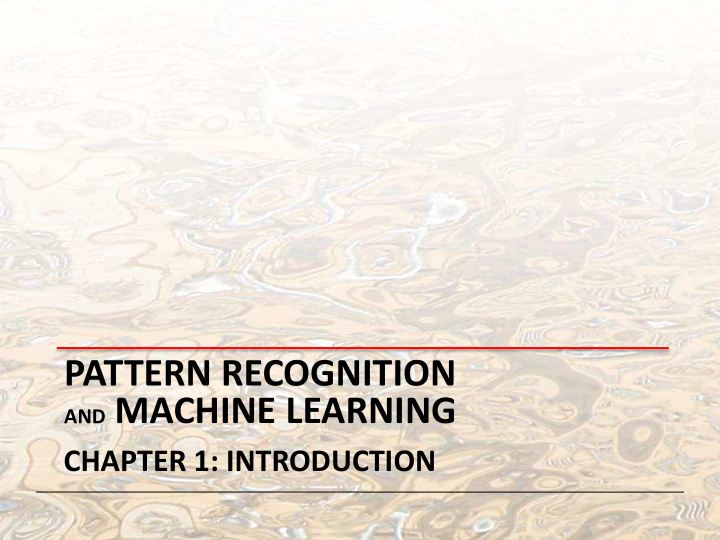



PATTERN RECOGNITION AND MACHINE LEARNING CHAPTER 1: INTRODUCTION
Example Handwritten Digit Recognition
Polynomial Curve Fitting
Sum-of-Squares Error Function
0 th Order Polynomial
1 st Order Polynomial
3 rd Order Polynomial
9 th Order Polynomial
Over-fitting Root-Mean-Square (RMS) Error:
Polynomial Coefficients
Data Set Size: 9 th Order Polynomial
Data Set Size: 9 th Order Polynomial
Regularization Penalize large coefficient values
Regularization:
Regularization:
Regularization: vs.
Polynomial Coefficients
Probability Theory Apples and Oranges
Probability Theory Marginal Probability Joint Probability Conditional Probability
Probability Theory Sum Rule Product Rule
The Rules of Probability Sum Rule Product Rule
Bayes ’ Theorem posterior likelihood × prior
Probability Densities
Transformed Densities
Expectations Conditional Expectation (discrete) Approximate Expectation (discrete and continuous)
Variances and Covariances
The Gaussian Distribution
Gaussian Mean and Variance
The Multivariate Gaussian
Gaussian Parameter Estimation Likelihood function
Maximum (Log) Likelihood
Properties of and
Curve Fitting Re-visited
Maximum Likelihood Determine by minimizing sum-of-squares error, .
Predictive Distribution
MAP: A Step towards Bayes Determine by minimizing regularized sum-of-squares error, .
Bayesian Curve Fitting
Bayesian Predictive Distribution
Model Selection Cross-Validation
Curse of Dimensionality
Curse of Dimensionality Polynomial curve fitting, M = 3 Gaussian Densities in higher dimensions
Decision Theory Inference step Determine either or . Decision step For given x , determine optimal t .
Minimum Misclassification Rate
Minimum Expected Loss Example: classify medical images as ‘cancer’ or ‘normal’ Decision Truth
Minimum Expected Loss Regions are chosen to minimize
Reject Option
Why Separate Inference and Decision? • Minimizing risk (loss matrix may change over time) • Reject option • Unbalanced class priors • Combining models
Decision Theory for Regression Inference step Determine . Decision step For given x , make optimal prediction, y ( x ) , for t . Loss function:
The Squared Loss Function
Generative vs Discriminative Generative approach: Model Use Bayes ’ theorem Discriminative approach: Model directly
Entropy Important quantity in • coding theory • statistical physics • machine learning
Entropy Coding theory: x discrete with 8 possible states; how many bits to transmit the state of x ? All states equally likely
Entropy
Entropy In how many ways can N identical objects be allocated M bins? Entropy maximized when
Entropy
Differential Entropy Put bins of width ¢ along the real line Differential entropy maximized (for fixed ) when in which case
Conditional Entropy
The Kullback-Leibler Divergence
Mutual Information
Recommend
More recommend